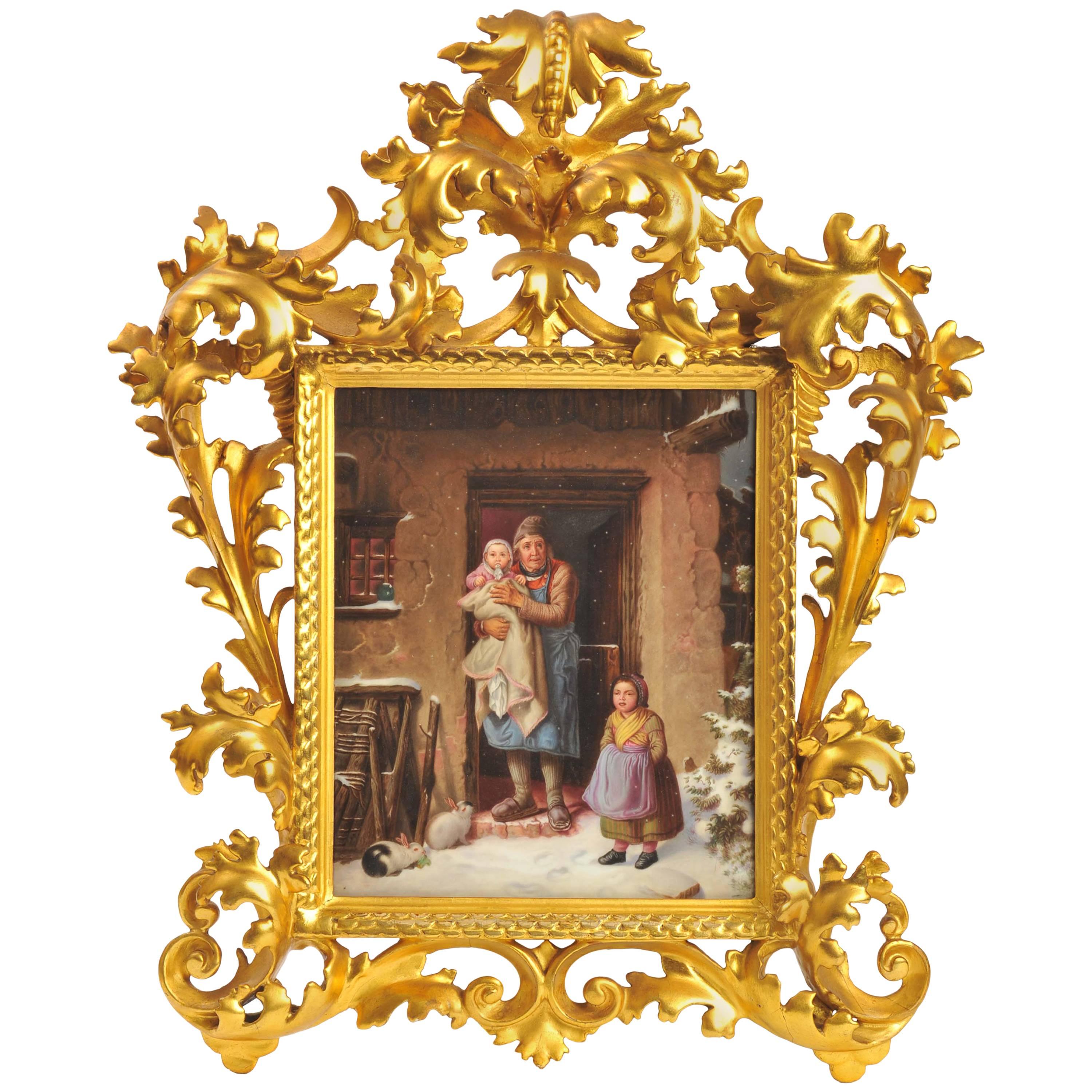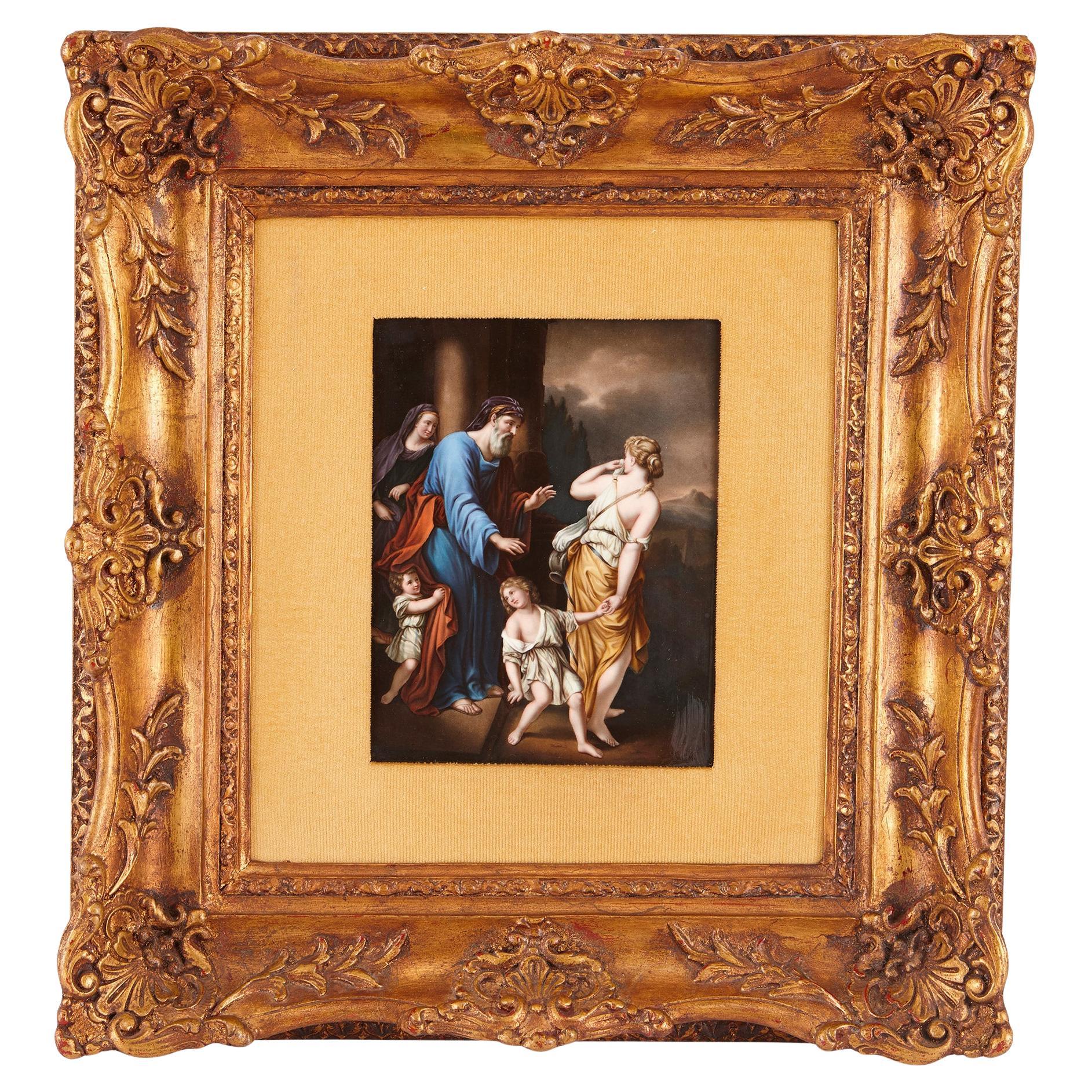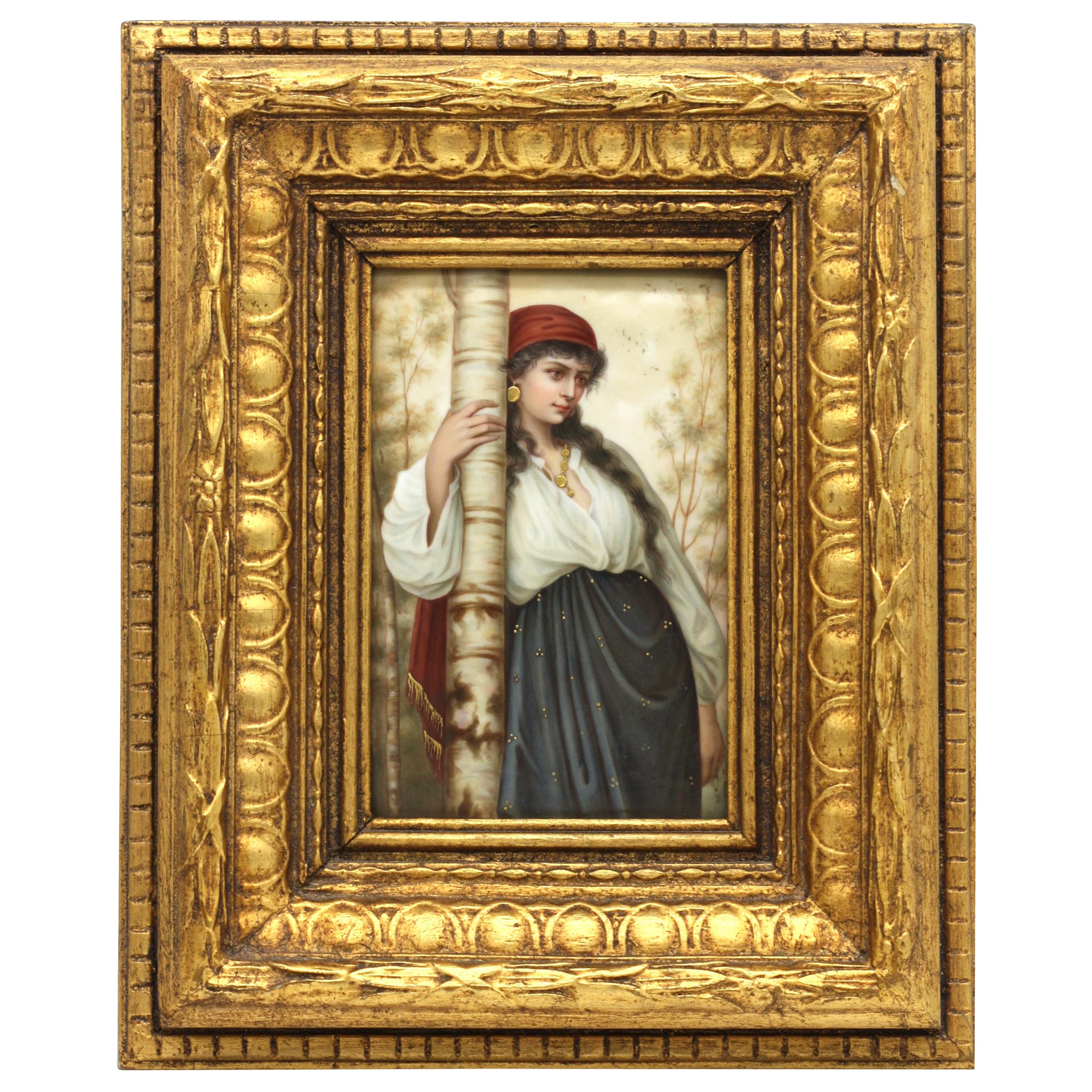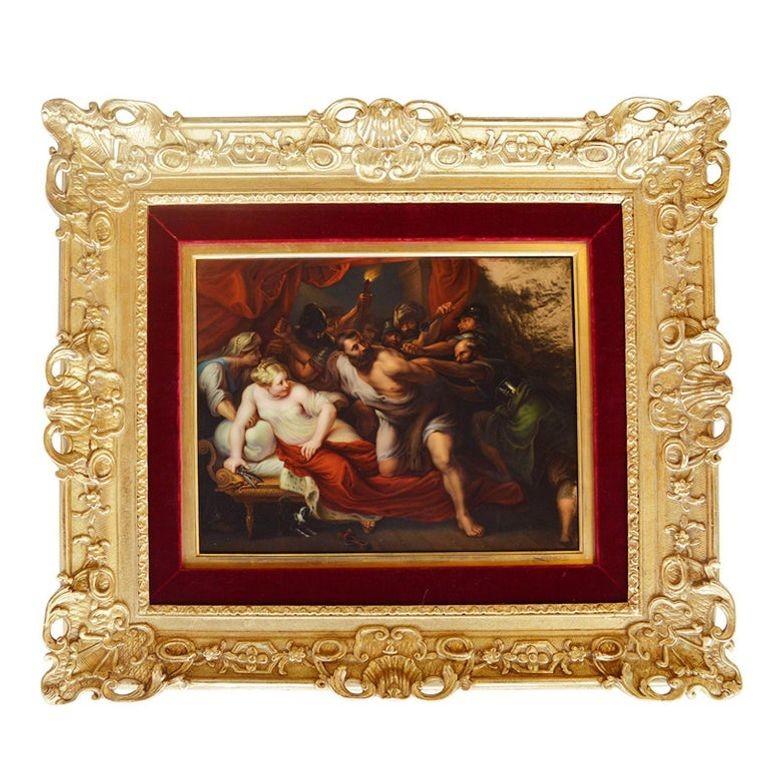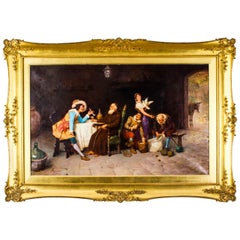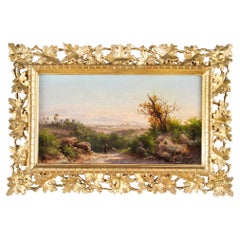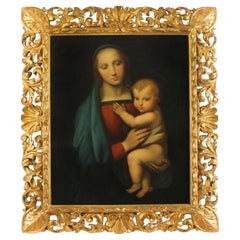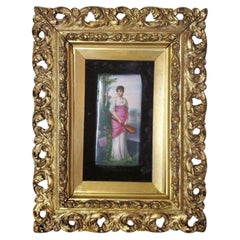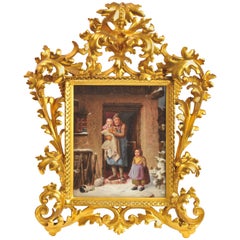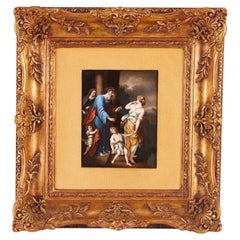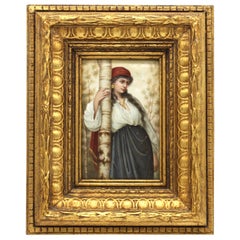Items Similar to Antique Berlin KPM Plaque 'KUNST BRINGT GUNST On Stand 19th Century
Video Loading
Want more images or videos?
Request additional images or videos from the seller
1 of 22
Antique Berlin KPM Plaque 'KUNST BRINGT GUNST On Stand 19th Century
$2,627.25
£1,900
€2,238.43
CA$3,640.18
A$3,950.15
CHF 2,093.23
MX$48,446.72
NOK 25,903.61
SEK 24,477.54
DKK 16,711.01
About the Item
This is an absolutely stunning and finely painted KPM Berlin Plaque after Paul Thumann's (1834-1908) 'Kunst Bringt Gunst' (meaning 'Art wins heart'), signed Knouller and raised on a decorative gilt bronze easel stand, circa 1880 in date.
This magnificent plaque is portrait in shape and depicts a candid young girl watching a graceful Greek artist while he is decorating a pottery vase. The young artisan is painting a black figure on the surface of the amphora while she is standing tall at the doorway and watching him.
Both figures dress in classical clothes and are set within a nostalgic environment reminiscent of antique ruins and of a paradisiac landscape. Indeed, a sweet and almost melancholy calm prevails. The original painting by the German artist, Thumann, just like many other of his romantic paintings, became very popular and was widely reproduced on porcelain plaques, plates and vases.
This truly splendid plaque is signed to the left bottom corner 'Knouller' and bears the impressed sceptre mark for KPM and comes with a Rococo style bronze stand.
It is set in its original splendid gilt frame displaying foliate decorations to the border and riased on a decorative gilt bronze easel stand.
Add this splendid antique plaque to a very special wall in your home.
Condition:
The plaque, the gilded frame and the easel are all in excellent condition, please see photos for confirmation.
Dimensions in cm:
Height 24 cm x Width 18 cm x Depth 2.5 cm - Framed Plaque
Height 43 cm x Width 20 cm x Depth 16 cm - Easel Stand
Dimensions in inches:
Height 9 inches x Width 7 inches x Depth 1 inch - Framed Plaque
Height 1 foot, 5 inches x Width 8 inches x Depth 6 inches - Easel Stand
The Royal Porcelain Factory in Berlin (German: Königliche Porzellan-Manufaktur Berlin, abbreviated as KPM), also known as the Royal Porcelain Manufactory Berlin and whose products are generally called Berlin porcelain, was founded in 1763 by King Frederick II of Prussia (known as Frederick the Great). Its actual origins, however, lie in three private enterprises which, under crown patronage, were trying to establish the production of "white gold" (i.e. porcelain) in Berlin from the mid-18th century onwards.
Before KPM was founded, two attempts had already been made to establish a porcelain manufactory in Berlin. In 1751, the Berlin wool manufacturer Wilhelm Caspar Wegely was granted the royal privilege to set up a porcelain manufactory in Berlin. Furthermore, Frederick II of Prussia granted him exemption from duties for the import of essential materials and assured him of the exclusion of all competition.
Wegely hired first-class craftsmen from his competitors, and appointed the porcelain sculptor Ernst Heinrich Reichard to the post of chief modeller. However, technical difficulties and the Seven Years' War between Prussia and Saxony soon proved to be the enterprise's downfall. In 1757, he dissolved his company and sold its inventories, equipment and materials to the Berlin businessman Johann Ernst Gotzkowsky.
In 1761, the second porcelain manufactory in Berlin started its operations. Gotzkowsky concluded an agreement with Wegely's chief modeller, Ernst Heinrich Reichard, who was in possession of the secret formula known as the arcanum. Reichard received 4,000 thaler for the arcanum, and another 3,000 for the stock of porcelain and other materials. Furthermore, he undertook to work for Gotzkowsky as a keeper of the arcanum and as the manager. Gotzkowsky also agreed to take over Reichard's eight workers.
Appreciated and supported by the King of Prussia, Gotzkowsky managed to attract important artists and qualified employees. Right at the start, Gotzkowsky appointed Friedrich Elias Meyer, a pupil of Johann Joachim Kändler who came from Meissen, to the post of chief modeller, and Carl Wilhelm Boehme to the post of head of the porcelain-painting department. Gotzkowsky bought another building next to his own property at Leipziger Straße 4, and he began to build a manufactory on the site.
Nevertheless, Gotzkowsky's finances began to deteriorate. Since the royal exchequer was in the red on account of the war, Gotzkowsky believed that he stood little or no chance of obtaining assistance from the king. The end of the war also signalled the end for Gotzkowsky's manufactory.
Today, the porcelain pieces from the early days marked with a W for Wegely und a G for Gotzkowsky are extremely rare and highly coveted collector's items.
On 19 September 1763, Frederick II officially became the manufactory's new owner. He purchased the manufactory for the considerable sum of 225,000 thaler and took over the staff of 146 workers. He gave the business its name and allowed it to use the royal sceptre as its symbol. From then on, it was called the Königliche Porzellan-Manufaktur Berlin ("Royal Porcelain Manufactory Berlin") and became a model of how to run a business. There was no child labour, there were regular working hours, above-average incomes, secure pensions, a healthcare fund and assistance for widows and orphans.
In 1784, after a four-year development period, the king's desire for a soft and delicate shade of blue was fulfilled. The colour was known as Bleu mourant ("dying blue"), and it was used to decorate Neuzierat, Frederick's favourite dinner service. The colour was predominant in the king's private chambers at Sanssouci Palace and in the blue chamber of the New Palace in Potsdam, as well as in other castles.
As owner of KPM, the king used the "white gold" as an effective means of diplomacy. Almost all of his diplomatic presents came from the manufactory, and they were to be found at the court of the tsars in Russia and on the tables of European aristocracy. Under Frederick the Great's successor, his nephew Frederick William II, the manufactory became a technologically leading enterprise. The new king obtained what he needed in the way of porcelain from KPM, but stopped paying cash. The amounts due were deducted from his share of the profits. The manufactory flourished. From 1787 onwards, the average annual net profit came to more than 40,000 thaler.
Our reference: A1094b
About the Seller
5.0
Platinum Seller
Premium sellers with a 4.7+ rating and 24-hour response times
Established in 1983
1stDibs seller since 2012
1,394 sales on 1stDibs
Typical response time: <1 hour
Associations
LAPADA - The Association of Arts & Antiques Dealers
- ShippingRetrieving quote...Shipping from: London, United Kingdom
- Return Policy
Authenticity Guarantee
In the unlikely event there’s an issue with an item’s authenticity, contact us within 1 year for a full refund. DetailsMoney-Back Guarantee
If your item is not as described, is damaged in transit, or does not arrive, contact us within 7 days for a full refund. Details24-Hour Cancellation
You have a 24-hour grace period in which to reconsider your purchase, with no questions asked.Vetted Professional Sellers
Our world-class sellers must adhere to strict standards for service and quality, maintaining the integrity of our listings.Price-Match Guarantee
If you find that a seller listed the same item for a lower price elsewhere, we’ll match it.Trusted Global Delivery
Our best-in-class carrier network provides specialized shipping options worldwide, including custom delivery.More From This Seller
View AllAntique Porcelain Plaque in Gilded Frame of Abraham 19th Century
By Berlin Royal Porcelain Factory
Located in London, GB
This is a magnificent and finely painted porcelain plaque, probably Berlin, finely painted with a portrait of Abraham expelling Hagar and her son, in a stunning giltwood frame.
The...
Category
Antique 19th Century German Paintings
Materials
Porcelain, Giltwood
Antique Oil on Canvas Painting by Francesco Bergamini 19th Century
By Francesco Bergamini 1
Located in London, GB
This is a truly splendid antique oil on canvas painting featuring a period interior scene by Francesco Bergamini (1851-1900) Italian, signed and dated 1894.
This beautiful oil pai...
Category
Antique 1890s Italian Paintings
Materials
Canvas, Giltwood
Antique Italian Landscape Oil Painting Guido Agostini 19thC
By Guido Agostini
Located in London, GB
A beautiful oil on canvas painting by Guido Agostini, Italian, 1865-1898, late 19th century in date.
The sensitively painted landscape shows a girl on a country road with the cit...
Category
Antique 1890s Italian Paintings
Materials
Canvas
Antique Painting Madonna & Child 'Paoletti and Ferretti' 19th Century
Located in London, GB
This is a beautiful oil on canvas painting after Raphael, depicting the Madonna and Child in the original giltwood Florentine frame, Circa 1880 in date.
It bears a label to the reve...
Category
Antique 1880s Paintings
Materials
Giltwood
Vintage Palladian Oil Painting Classical Roman Ruins, 20th Century
Located in London, GB
This is a beautiful oil painting in the Palladian style featuring a classical scene of Roman ruins, with a family fishing in the shadows of the ruins and dating from the second half ...
Category
Vintage 1970s Paintings
Materials
Canvas, Giltwood
Antique Water Colour Attlio Simonetti 'The Music Recital' 19th Century
Located in London, GB
This is a beautiful antique watercolour entitled "The Music Recital" by Attillio Simonetti (Italian 1843 - 1925) signed Attillio Simonetti, Roma, bottom right and Circa 1890 in date...
Category
Antique 19th Century Italian Paintings
Materials
Canvas
You May Also Like
19th Century KPM Berlin Painted Porcelain Plaque, Die Lautenspielerin
By KPM Porcelain
Located in Forney, TX
A late 19th century Berlin KPM painted porcelain plaque, Die Lautenspielerin, in pierced foliate giltwood frame, painting after Friedrich August von Kaulbach (German, 1850-1920). Mod...
Category
Antique Late 19th Century Victorian Paintings
Materials
Porcelain, Giltwood, Paint
19th Century KPM Porcelain Plaque
By KPM Porcelain
Located in Brighton, Sussex
A good quality 19th century KPM porcelain plaque, depicting a mother and her children on a winters days.
Mounted in a 19th century carved gilt...
Category
Antique 1860s European Porcelain
Materials
Porcelain
19th Century KPM Porcelain Plaque, after Old Master Painting
By Königliche Porzellan-Manufaktur (KPM)
Located in London, GB
19th Century KPM porcelain plaque, after Old Master painting
German, 19th Century
Plaque: Height 24cm, width 18cm
Frame: Height 53cm, width 50cm, depth 8cm
This fine KPM porcelain p...
Category
Antique 19th Century German Victorian Porcelain
Materials
Porcelain, Giltwood
Berlin 'KPM' Style Porcelain Plaque, circa 1880
Located in West Palm Beach, FL
A Berlin (KPM) style porcelain plaque, circa 1880
painted with a gypsy girl standing beside a tree with gilt highlights, in a later giltwood frame, size with frame 10 x 8 in. (25.4 ...
Category
Antique 19th Century Paintings
Materials
Art Glass
Late 19th Century, German KPM, Hand Painted Porcelain Plaque
Located in Los Angeles, CA
Late 19th century, German KPM, hand painted porcelain plaque.
Category
Antique 19th Century German Paintings
Materials
Porcelain
After Emil Rau A Fischer and Mieg Porcelain Plaque
By Fischer & Mieg Pirkenhammer
Located in West Palm Beach, FL
After Emil RAU (1858-1937)
A Fischer and Mieg Porcelain Plaque,
second half of the 19th century
painted with a tavern scene of two gentlemen in lederhosen ...
Category
Antique Early 1900s Paintings
Materials
Porcelain

